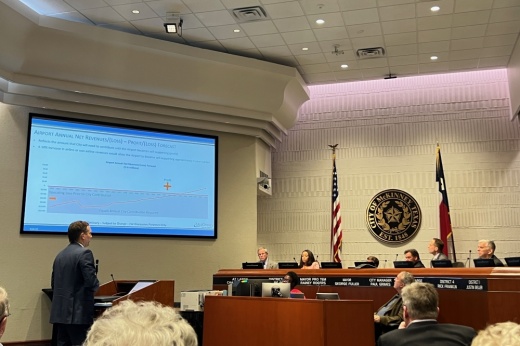The proposed expansion includes adding a new terminal and commercial passenger service to the existing general aviation airport. A $200 million bond proposal to fund the expansion is on the May 6 ballot.
A presentation at the meeting by project consultant Adam Giombetti detailed aspects of the financial model and projections for the proposed expansion.
Here are five things to know about the finances of adding a commercial service terminal to McKinney National Airport.
1. The project is expected to have multiple funding sources.
The project’s total cost is estimated to be $300.7 million, but the bond proposal is only for $200 million. The remaining $100.7 million is expected to be sourced from federal grants and low-interest federal transportation infrastructure loans, Giombetti said in his presentation.
“As the airport becomes commercial, there’s additional grants that ... the airport becomes eligible for that’s not reflected in this model, but that would help for any construction costs that might come down the road,” Giombetti said.
2. The estimated revenue is dependent on the projected number of passengers.
A passenger forecast was used to determine the revenue output of both airline and nonairline activity, according to the presentation.
The passenger forecast gave a range of potential traffic to the airport, with anywhere between 178,000 and 888,000 passengers departing from the airport in its first operational year. The consultants opted to use 533,000 departing passengers as the middle ground estimate of the range, which included very high traffic and very low traffic scenarios.
“For the financial model, we took kind of the middle ground there. We felt that was a fair and reasonable approach that we would use, which is about 533,000 enplanements, and that is growing about 3% over time,” Giombetti said. “If we look at Collin County and McKinney over the years ... we’re expecting higher growth than that, so we felt that was another conservative estimate for the forecast.”
3. The airport is expected to become self-sustaining in 2048, based on projections.
Based on assumptions from the passenger forecast, proposed project timeline, projected revenue and airline start-up costs, the airport is expected to become financially self-sustaining in 2048, according to the presentation.
The break-even point would be when the revenue covers both the cost of operations and the debt service of the bond, Giombetti said. The timeline for when the proposed expansion would break even financially can be swayed by changes in airline and nonairline revenues, passenger traffic, and more, according to the presentation.
“When we look at the actual operations of the airport, the airport can pay for itself from the operating standpoint. It can cover its general expenses on an annual basis,” Giombetti said. “It’s the debt service that is required to fund the infrastructure to build this airport from scratch that [needs] the city’s help.”
4. The proposed expansion is a revenue-generating capital improvement project.
Unlike most capital improvement projects, the airport expansion would be revenue-generating.
Other capital improvement projects, such as road improvements, city facilities and parks, often do not have a revenue-generating aspect, McKinney Mayor George Fuller said. This project would also be eligible for grants and other funds to pay down the debt, something not commonly found in other capital improvement projects, Fuller said.
“Because we ultimately pay off debt, and then we have revenues that come to the city, that would differentiate it from virtually all other capital improvement projects and all other bonds we’ve ever voted on as a community,” Fuller said.
5. The financial outlook for the airport expansion could vary.
Factors—including passenger traffic, operations and maintenance costs, nonairline spending, and grant funding—have an effect on when the proposed expansion would become self-sustaining.
Increases from the projections for passenger traffic, nonairline spending at the airport and grant funding could all lessen the amount of time it would take for the project to be self-sustaining, according to the presentation. Conversely, decreases in those categories as well as increases in operating costs could delay the break-even point.
Next steps
A second open house to review draft environmental impact results will be held from 6-8 p.m. April 19 at Cockrill Middle School, 1351 S. Hardin Blvd.
The $200 million bond proposition will be on the May election ballot. Early voting begins April 24, and election day is May 6.
For more information on the proposed expansion of McKinney National Airport, visit www.fly-mckinney.com.





